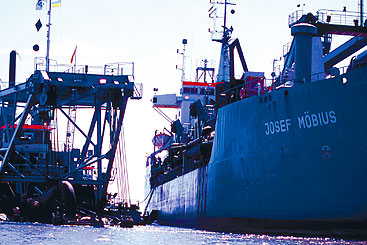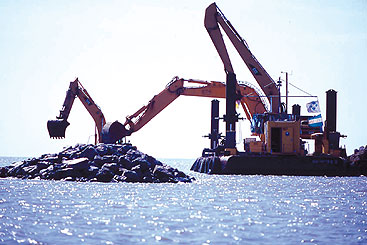
Finding a common ground for international cooperation
Despite earlier positions, the controversial Bystroe Canal project is now on course with a focus on international cooperation and open dialogue.

According to a UNECE report, dredging will have an impact on the water level dynamics along the Bystroe Branch that will result in the loss of floodplain habitats.
At the beginning of the year, discussions on the controversial Renovation of the Danube-Black Sea Navigation Route had stalled. The Inquiry Commission of the United Nations economic Commission for europe (UNECE) issued a report in 200 concluding that the bystroe canal will have “significant adverse transboundary effects” on the environment and should be stopped until the ecological consequences could be properly evaluated. Ukraine, however, was proceeding with the project, and believed that all international organisations had been fulfilled.
The ICPDR had expressed concern about the possible impacts of the project as early as 2003, and has closely followed developments and established an active dialogue with representatives of Ukraine and neighbouring countries. The ICPDR has continued to reinforce the need for the requirements of international conventions to be upheld to ensure that neighbouring countries affected by the project are properly informed of the project and have input into how the project could be developed or adjusted to reduce or eliminate transboundary effects.
“The Ukrainian Party is open for an active dialogue with the espoo Convention Secretariat and its appropriate bodies,” said Deputy Prime Minister of Ukraine hryhoriy Nemyrya, and Ukraine “is ready to sign bilateral agreements with the Romanian Party”.
International organisations working together. The Convention on Environmental Impact Assessment in a Transboundary Context (Espoo Convention) brings together all stakeholders to prevent environmental damage before it occurs. The Espoo Convention requires that Member States notify and consult each other on all projects that might have an adverse transboundary environmental impact.
In April of this year, some 12 intergovernmental organisations met the Executive Secretariat of the Espoo Convention to exchange information on the project and to coordinate their actions and responses. This meeting led to an agreement that UNECE would draft a letter to Ukraine outlining concern that the commitments and obligations under various conventions were not being upheld in connection with the project. This letter was sent in May with a background document on the international obligations.
Furthermore, as part of the preparation of the Conference of the Parties to the Espoo Convention (COP) in Bucharest, Romania, on 19–21 May, the Implementation Committee of Espoo prepared a report issuing a caution to the Government of Ukraine following the receipt of the information that Ukraine was proceeding with the project.

Ukraine has expressed that it will participate in active dialogue with the ESPOO Convention Secretariat and its appropriate bodies and that they are ready to reconsider their decision on the project.
Changing course. Following initial discussions at the meeting about the Implementation Committee’s report, Ukraine presented a statement that it was changing its position regarding the future steps in the project. In particular, Deputy Prime Minister of Ukraine Hryhoriy Nemyrya stated in a letter to the UNECE that “The Ukrainian Party is open for an active dialogue with the Espoo Convention Secretariat and its appropriate bodies” and stressed that Ukraine “is ready to sign bilateral agreements with the Romanian Party".
After lengthy debate, the COP adopted a resolution issuing “a caution to the Government of Ukraine to become effective on 31 October 2008 unless the Government of Ukraine stops the works… and takes steps to comply with the relevant provisions of the Convention”.
The resolution also requested Ukraine to ensure that its legislation and administrative measures are able to fully implement the provisions of the Convention, and to submit a new strategy and schedule of the project based on the outcome of an independent review.
RENOVATION OF THE DANUBE-BLACK SEA
NAVIGATION ROUTE
Much of the national and international controversy surrounding this project arises from its location. The Danube Delta, spanning the border between Romania and Ukraine, includes UNESCO Biosphere Reserves and a World Natural Heritage site. It is a wetland rich in plants (over 1000 species), birds (300 species, including the largest pelican colony in Europe) and fish (including several endangered species of sturgeon).
The Bystroe Canal would aid navigation through the Danube Delta, and would increase inland shipping by more than 60%, according to a feasibility study conducted in 2003. Unlike the Sulina Canal in Romania, the Bystroe Canal is designed to accommodate two-way traffic around the clock. The canal, according to initial reports, would be three times cheaper to pass than the Sulina Canal, allowing Ukraine to better compete for international shipping.
Getting interested parties involved. In addition to the activities requested by the Espoo Convention, and at Ukraine’s encouragement, the Bern Convention Secretariat – with representatives from the various commissions – made a visit to the site at the end of July.
The ICPDR is also planning a set of meetings, with funding from the UNECE, related to the Danube Delta and water issues. The project will look at sharing information between Moldova, Romania and Ukraine on water resource issues in the Danube Delta. “Success in this matter is a result of the secretariats of the international commissions all working together,” said ICPDR Executive Secretary Philip Weller.
Disclaimer
The information contained in the ICPDR website is intended to enhance public access to information about the ICPDR and the Danube River. The information is correct to the best of the knowledge of the ICPDR Secretariat. If errors are brought to our attention we will try to correct them.
The ICPDR, expert group members, nor other parties involved in preparation of information contained on this website cannot, however, be held responsible for the correctness and validity of the data and information provided, nor accept responsibility or liability for damages or losses arising directly or indirectly from the use of the information conveyed therein.
Only those documents clearly marked ICPDR documents reflect the position of the ICPDR.
Any links to other websites are provided for your convenience only. The ICPDR does not accept any responsibility for the accuracy, availability, or appropriateness to the user's purposes, of any information or services on any other website.
When using the information and material provided on this website, credit should be given to the ICPDR.
